
Replaced Coins

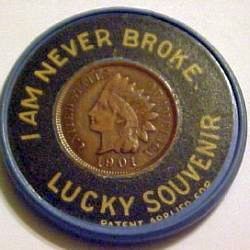
Vulcanite encased Pan Am Temple of Music 1901 Pan Am Exposition, Buffalo, NY
Written by Bob Perdue
This Bob Perdue is no relation to Bruce Perdue webmaster of Encased Coins Dot Info. The following article is reprinted with permission.
Soon after you decide to pursue the hobby of encased collecting the subject of replaced coins will surely arise. With that subject there will be a host of related topics such as; How do I detect a replaced coin? What is the value of an encased with a replaced coin? Why would anyone want to replace a coin in an encased? Digital photography has made it possible to give working examples on the subject of replaced coins in a way that just can not be as readily understood in text alone.
I believe the three most authoritative authors on the subject of encased coins in alphabetical order are; (1) Duane Feisel (2) James Lawniczak (3) Bryan Ryker. I have read their comments on replaced coins in encased and will intersperse them into this article. I will footnote their catalogs at the end and if you require additional information on the subject you can refer to them.
Nondestructive Tests
Much information can be gained by simply looking at an encased and observing its overall condition. Does it have heavy wear, is it dirty, and is there visual evidence of tampering?
There is also a lot to be said for common sense. If the encased is dated 1920 should it have a 7 digit phone number or a zip code on the address of the business? The majority of the Word's Fair and Exhibition pieces were held in a specific year i.e. the Pan-Am Exhibition in Buffalo, NY was in 1901 and the St. Louis World's Fair was in 1904. The encased from these events will bear coins from those corresponding years. A few encased will bear inscriptions such as "Good luck in 1929 and all the years to follow. If you see an encased of this type with a coin dated much earlier it is most likely replaced or if it is much later then it is almost impossible to be original.
Another common sense tip that Jim Lawniczak passed along to me was that in almost all cases an original Indian head encased penny will have a full LIBERTY on the headband even if the encased has heavy wear. It must be the way those coins were oriented that they just didn't wear in that area as rapidly.
Here is a very, very dirty 1935 encased cent from the Winterbottom Oyster Company. Under normal circumstances this would be a very desirable collectable, but look a bit closer. It has had holes drilled into it, is much pitted, slightly bent, and has corrosion. What do you think the chances are that the cent is original? At the point where you notice these types of distractions you should question the originality of the cent and examine the piece much closer before purchasing it. Most of the time no single factor will determine if the coin is original; it will take a variety of factors and multiple tests to determine its authenticity.


Winterbottom Oyster Company(hover for larger image)
A 1935 fob style encased that might offer a lesson. In almost all cases the coin will be oriented on a straight north to south axis. Here you can see the head of the Lincoln cent is pointed more towards the 1:30 - 2:00 o'clock position. This is not an automatic indication that this is a replaced cent, but it should raise a red flag and make you suspicious and cause you to take a look closer. Now look between the 2:00 and 3:00 o'clock position. Notice the deformation in the aluminum ring? Has this been tamped with a punch or other tool to secure the penny to the encasement? The only way to be sure will be to conduct more tests. The point is to observe the encased and learn to spot these indications.
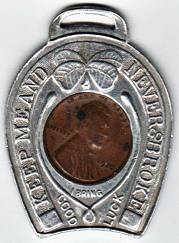

1935 fob style (hover for larger image)
Wow! An 1885 encased cent. What a rare find and one that should raise more red flags than the Indianapolis 500. It is very rare to find an original encased with a coin dated before 1901. They are out there but they are very rare.
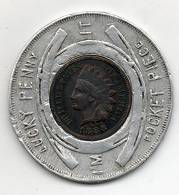

1885 Encased Indian (hover for larger image)
Let's look again at the example and the orientation of the cent in it. If the encased were aligned on a true north to south axis the wording would be at the top and also some at the bottom. That would make the cent almost on a true east to west axis and that just doesn't happen. In his book Bryan Ryker describes how encased were made and says this. "Each encased coin had to be made by hand, one at a time. The operator loaded an aluminum ring into the press and then inserted the coin, being careful to align it properly by eye." These machine operators made thousands of these encased everyday and were expert at it. There may be slight variations in the orientation of the coin in the encasement, but those variations are only very slight. There may also be variations by manufacturers; all of them had different acceptable practices. If the regular operator called in sick and a "fill-in" person were assigned the job for the day then also there may be a noticeable difference.
On some encased there is also another factor in determining originality and that is that the cent is slightly warped or buckled due to the stamping process. Study your encased and you will notice this on many of them, but not all.
The above example would be an encased you would not want to purchase at any price. It's only value would be in the aluminum and the penny
To make things harder in detecting replaced coins some of the current encased manufacturers are minting encased with much older coins in them. I have been told by several people that there were no original encased with 1943 steel cents in them. During the war years metal was scarce and not a lot of it was wasted on non-essential things. Yet you can find modern encased with steel cents. You can also find foreign coins, buffalo nickels, and a host of other sizes and assortments. It seems there is a race to come up with the most unusual encasement. The only harm in any of this is that a new collector thinks they are purchasing something that is rare and was made during the war years; this is where the problem comes in. I have been going though the encased orders for the Osborne Coin Company and even back in the 1950's customers were requesting Indian head cents for their advertising encasements. You'll also see instances where in 1955 a customer would order encased and request cents from another year. It's also not uncommon to find Canadian cents and denominations other than a cent being encased. As a collector it is better to error on the side of caution and always suspect tampering when encountering something too good to be true.
An original encased from 1950 that doesn't have a coin at all, but rather a token in it.
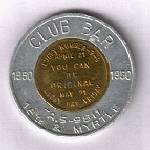

Encased Token (hover for larger image)
Modern encased like this will often offer you another valuable lesson and that is coin dealers are not experts on encased or exonumia in general. A dealer many times will determine the value of the encased by the grade and rarity of the coin that has been encased i.e. if an AU 1935 cent is in the encasement then the dealer will look up the value of the cent and ask a corresponding price. If the cent is loose or not original it makes no difference to him. He is selling you the cent and caveat emptor. I once had a very reputable coin dealer that I have lot of respect for offer me a blazing red 1901 encased cent from the Parke's Coffee Company. That's not really that rare of an encased, but any encased with a full red Indian head cent in it is desirable. I looked at the encased and noticed right off that the cent was loose. I examined it a bit closer and it there were obvious tooling marks on the encasement. I commented to the dealer that it was such a shame that such a desirable collectable had been ruined and was of little value. He laughed and told me the story of what had happened. He had bought the encased and he had taken pliers and popped the cent from the encasement. He then sent it to PCGS or another coin grading company thinking it would come back as being MS65 or higher. What happened was that the cent was sent back to him and not slabbed at all. They were even able to tell him that the cent came out of an encasement and was considered damaged. He was very much surprised by this news and was trying to sell the encased for $125.00 which he said was the value of the cent. When I last spoke to him he still had the encased, but I suspect at some point he will sell it to a coin collector and not an encased collector.
I'll expand on this with another example of misinformation by coin dealers. At one point there was an encased from the 1901 Pan-American Exhibition in Buffalo, NY on an Internet auction. These are very common items that regularly are listed in the auctions. This particular encased had an 1888 Indian head cent in it. The dealer listed it as being very rare. I was a bit upset with his assertion and contacted him via email explaining to him that the encased from the exhibition had been catalogued extensively and that all original examples like his had 1901 cents in them. His item was not very rare at all and in fact was altered and of no value at all. He responded that he had been collecting encased for years and in fact had the Pan-Am encased with I think it was 26 different dates in them. The point is you see what you're up against. There is much misinformation to be found and dealers at flea markets are not authorities. Learn to do your own detective work; don't buy into what you're told by vendors out to make a buck.
Here is a rather crude replaced cent. Obvious tooling marks at the top of the cent are a dead give away. It should also be noted that the cent should usually be flush in the encasement. If it is protruding in any area then that is an indication that there may be a problem.
Return to Top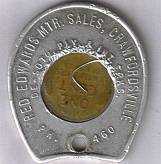

Crude Replaced Cent (hover for larger image)
Another encased from the Pan-American Exhibition and one we stand to learn a lot from. This coin is oriented in reverse. Almost all encased have good luck slogans such as keep me and never go broke on them. In almost all cases the front of the encased coin will be oriented with the side of the encasement that has the good luck slogan on it. In this case the Pan-Am series has been very well catalogued and the front of the Indian head cent is always oriented with the four leaf clover side of the encased that says good luck souvenir. This is something you can learn from examination and study of encased coins.
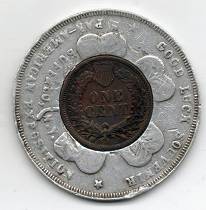

Replaced cent (Hover for larger image)
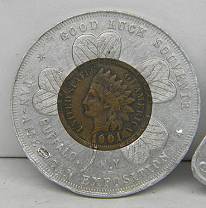

Correct 1901 Pan Am Cent (Hover for larger image)
Above on the left a replaced cent. Note that the reverse is inserted on what is the obverse side. The coin is oriented incorrectly as well. Further note on the example on the right how the stem of the four leaf clover and leaf design is stamped on the cent and the encasement. This is not true on the example on the left.
Here (above) is another encased just as above from the 1901 Pan-Am Exhibition. In this case the cent is oriented as it should be. I wanted to include this to make a point. In almost all cases in this variety you can spot an original by looking at the cent. The stamping pattern of the 4-leaf clover will extend onto the cent and also the stem of the clover will carry over onto the cent. If that isn't the case look more closely as this is an indication of a problem and may require other tests.
Notice any problems here? Where an older looking encasement has more elaborate scrolling and design work more often than not they will have an Indian head penny in them; this does not. The cent is oriented wrong. There are tooling marks near the word of. It also looks as if the cent just wasn't intended to fit the encasement. Encased were made with a stamping process and there will almost always be a tight seal between the cent and the aluminum encasement. If there is not it is usually an indication of tampering. Although in some encasements where the encasement is made of steel or brass there may not be complete seal because of the hardness of the metal used.
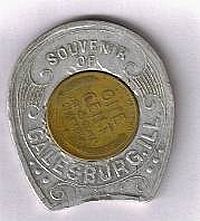

Galesburg Horseshoe (hover for larger image)
Here is a final example that will highlight a few of the key points to look for. (1.) The cent is dated 1890 (2.) There is no full LIBERTY on the headband of the portrait of the Indian (3.) The cent is orientated more towards 10:30 - 11:00 than straight up 12:00. (4) The cent doesn't appear to fit the encasement at all and it looks as if there is a gap between the cent and the encasement extending between about 11:00 and 2:00 o'clock. There is also another smaller gap at the bottom near the 6:00 - 8:00 o'clock position.
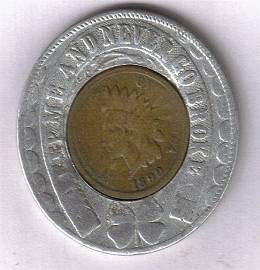

Worn Liberty (hover for larger image)
It is not always easy to spot a replaced coin in an encasement. If you were to look in any of the major coin newsletters or search the Internet you will find advertisements for "coin doctors" These are artisans that have a talent for repairing damaged collectable coins. A coin may have a slash or other disfiguring defect and they can repair the slash and make the coin much more pleasing to the eye. Of course if you were to try and have the coin graded by a professional service they could spot the repair, but many times they are undetectable to the naked eye. I have seen encased that have been professionally repaired and have seen some very good work. The fact is that even an expert can be fooled. The value of most encased with circulated cents is not high enough to encourage counterfeiting and or extensive coin repairing. These artisans charge by the hour for their work. A typical Indian head encased cent might be expected to be worth $20.00 - $50.00. You will soon run up a higher tab than that trying to have one repaired, thusly most of the repair type work is of a low quality nature by unprofessional individuals and is easier to detect.
The Light Test
The light test is a test that it is most likely you won't be able to perform at a coin shop or coin show. It will also be useless for encased on Internet auctions. Most encased intended for purchase are housed in 2x2 Mylar type holders. They have been stapled shut and dealers don't take well to the idea of you opening them up and examining the piece. If you do then they have to staple it back shut. I always consider the value of the encased in question. If it is a $5 to $10 encased then I will just use the common sense tests as discussed above. If I get burned every once in a while so be it. If it is an encased on an Internet auction then really you are at the mercy of the seller. Digital photography is great, but it is not a substitute for hands on examination. In any event if you do purchase an encased and are not convinced of its merit the light test is a great method for exposing replaced or damaged encased.
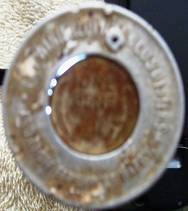

Light Test (hover for larger image)
I wish I had better photography equipment to work with, but I don't. In order to perform the light test all you need to do is place the encasement on top of a bright light. In this case I used one of those mag-light type flashlights that are readily available. If you don't have one you can use a light bulb in a darkened room. This is the Winterbottom Oyster Company encased that was pictured above and as you can see in the picture in the area where the coin doesn't match up with the encasement light shines through. This is a dead give away that the coin in the encasement has been removed at some point. Where there are massive areas of light shining through there is a strong indication that the coin is not original to the encasement, because as we discussed earlier the stamping process in encasing seals the coin to the encasement. When you become comfortable performing this tests try it on encased where you are certain the coin is original. You will find that no light at all passes through. What you may encounter though is another situation that has not been discussed yet. It is possible that at some point the original coin in the encasement for some reason has become dislodged, taken out of the encasement and then put back in. Refer back up to the example of the 1901 Parke's Coffee encased where the coin was taken out by the dealer. What would happen if you were to do the light test on that encased? If you were to put the penny back in and orient it just right I think it might pass the light test as it would be just as it was when it was stamped. However if the penny was not oriented just right or maybe a burr was on the encasement and disturbed then a slight sliver of light might shine through in one area. Therefore the light test is not absolute in determining if the cent is original to the encasement. An encasement with a loose original cent is a far cry from an encasement with a replaced cent.
Jim Lawniczak notes exceptions to the light rule and states that reeded edged coins such as a quarter may be original and fail the light test.
In his book Duane Feisel posits a couple of other useful considerations in detecting replaced coins. One of them is common sense and he suggests the use of magnification to spot tooling and tampering. It might also be helpful in spotting something else that he discusses and that is the use of super glue or epoxy type cements to bond the coin to the encasement. The glues that are made today create a strong bond that will hold the coin indefinitely. You may be able to spot globs of glue that have seeped out and maybe they are a bit discolored. Many times an encased with a coin that has been glued in will not pass the light test. Coins have tolerances like any other manufactured product. All cents have a slightly different diameter if a cent has been removed and replaced with another the seal with the encased has been broken and tell-tale signs of tampering may be obvious. I once talked to a collector who told me that he used a product called Alumaseal to seal coins back in encasements with. He said this product was designed for automotive radiators and it set-up as hard as a rock. I don't think I have ever seen one of these but would suggest that a lot of time would be required to machine the encasement back to a level where the repair wasn't obvious. I just don't think many people would be willing to forego such a time consuming procedure for so few dollars in return. It is also acceptable to carry a magnifying glass with you while at the coin shows and examine encased even though they are in the 2x 2 holders.
Another aspect that Duane covers in his book is the use of "reseating dies" I have never seen one of these devices but have a mental picture of one being something like an aluminum can crusher. It would have a pull handle than you press down over the encasement with the loose fitting penny. The reseating would be accomplished with a die slightly larger than the coin and would create a bonding seal that would pass the light test. This same process might be accomplished on a workbench with a fixture and a vise. I went through the encased I have a tried to come up with something that may have been reseated and found this;
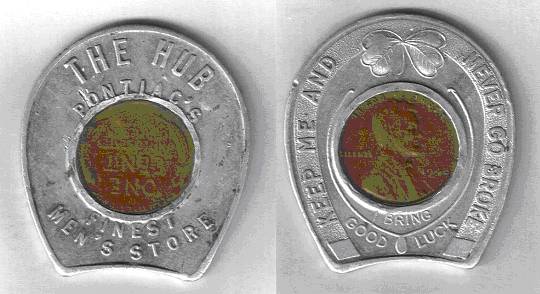

Reseated? (hover for larger image)
Look at the example and compare it with an encased from your collection. There is a definite ring on both sides of the encased and on one side it appears they have tried to hammer it down a bit. This piece will pass the light test, but is still a sham, and a poor one at that. Another helpful aid to mention at this point is the cataloging of encased coins. If you intend to collect encased from a specific state and a catalog is available it will be a tremendous aid to you because you can look at the entries and see what dates were cataloged. If a variety shows up with a date not cataloged suspect tampering and investigate more closely.
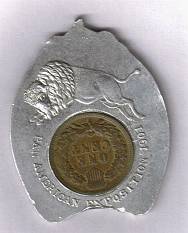

Pan Am Buffalo (hover for larger image)
Some encased pose special considerations that you may encounter. This encased is a wishbone style and is from the 1901 Pan-Am series and features the charging Buffalo at the top. This is a very desirable encased and one that comes up only every so often. You will often see this encased with a loose, original cent. The reason why is that this encasement was made with very thin aluminum. You can check these with micrometers and see that they are about .0055 - .0060 thick. Typical wishbone style encased will be about .0065-.0070. Why does this small difference in thickness make such a big difference? It's because an Indian head penny will be about .0052-.0055 thick. On this Pan-Am variety there just isn't much excess metal to hold the penny in tightly and any slight distortion or heavy jarring will dislodge the penny. Be wary of purchasing this variety, it is very rare to find one where the penny is not loose. I suspect what happened here was that the manufacturer ordered some sheet aluminum at a non-standard thickness, perhaps as an experiment or a way to save money to see if it would work as well. When they found that it would not they returned to the standard thickness. One thing to keep in mind is that during the Civil War period aluminum was more expensive that gold. It wasn't produced commercially until the 1890's. I don't know what the price of aluminum was in 1901, but suspect it was a huge factor in producing encased.
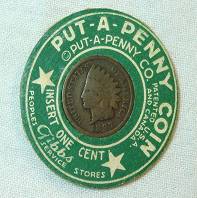

Put-A-Penny (hover for larger image)
Let's don't get too far off of the subject here, but what is an encased coin? The word encased means; to enclose, as in a case. Then an encased coin would be a coin that is enclosed, as in a case. Many collectors read into the word encased that it infers a permanent or affixed coin but that is not the case. In encased like this one coin can be popped out and replaced with another as often as you like. There are also other examples like this that encase a coin for a parking meter or other singular purpose. On these types of encased replaced coins are not factors in value.
Other Tests
Jim Lawniczak suggests a couple of other tests that merit mention. One method he calls the "in tight test" and suggests this method. While the encased is still in the 2x2 holder place your thumb and forefinger onto the coin itself; gently push on the coin with your forefinger and catch it with your thumb to detect if the coin is loose in the encasement. DO NOT push too hard or you will dislodge the coin in testing. If the coin is loose you won't need a hydraulic jack to determine that; it will be obvious.
Another method of Jim's is the "ringing test" In this test you drop an encased from a low height onto a solid surface and listen for the tone it makes. Try this on a desk top or table top. Listen to the sound the encasement makes as it lands. A clear ring is an indication that the cent it tight while a hollow ring indicates tampering.
Hopefully all of the above information will serve to make you a better detective in building your encased collection. I'll try to answer another question and that is why do people alter or repair encased to begin with? The most obvious answer would be for the money. Many people are motivated only by the dollar. I have talked with flea market vendors who have shown me encased that they have "doctored" and now have for sale. One guy told me that he had spent all morning scouring the flea market looking for wheat pennies to put in his empty encasements. These encased are bought and then passed onto unsuspecting collectors. Many times coin dealers will buy these types of encased and that points to another reason and that is ignorance on the subject. Coin dealers oftentimes sell encased based on the value of the coin that is encased and not on the basis of the authenticity of the encased. They see no harm in this practice. If you are unfortunate enough to have purchased one then it is likely you possess a nearly worthless collectable. A final reason that is often times over looked in replacing coins in encased is the fact that many encased are very, very rare and a collector simply wants one in his collection and so he either affixes a coin to an empty encasement or hires the job out. He would rather stare at an encasement with a replaced coin than a shell of one without.
Here is an encased from my own collection. It has a 1901 cent in it. I'm also certain that it has a replaced cent in it. This is an encased that exists with a very low population; there may only be 1-5 of these known. As a collector I prefer to possess this with a replaced cent, rather than an empty shell. I have never seen another one of these if I waited until an original one came along I might never have one.
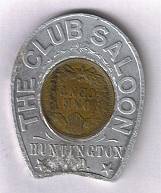

The Club Saloon (hover for larger image)
The subject of replaced cents would exist without the motive of greed. There are manifold reasons for possessing damaged encased coins. Then let's just take it as a given and assume these examples will always be available. How can a collector protect themselves? Again some measures are obvious. It is very hard to look at a picture and tell if an item is genuine. If you are bidding in an Internet or mail-bid auction the first thing you should notice is what is the seller's return policy? If a seller doesn't allow returns there may be a good reason for that. Reputable sellers or dealers will always offer you a return period. It may be 5-10 days, but it should offer you a period of examination for your purchase. Also look at the sellers other items. If he has a history of selling exonumia then you might expect him to have knowledge on the subject and sell authentic items. In all cases feedback is determinate in choosing to place bids. Sellers with sordid histories are soon exposed for what they are.
Exonumia clubs such as TAMS and NTCA require that their members uphold a pledge of ethical conduct in order to remain a member. I'm not a member of TAMS, but in the NTCA Code of Ethics - Article 2, Section1, Number 6 states that members are forbidden "to sell any repaired item if not clearly represented as "repaired" and not in anyway misrepresented as original." Internet auctions do not hold sellers to these tight standards and instead rely on feedback from the buyers to define a seller's integrity.
This subject is of some interest to me and I will give my opinions on the selling of encased with replaced coins. If you watch the TV court shows at all you no doubt have had some exposure to contract law. In all transactions there is some type of oral or visual dialogue between the seller and the buyer. For in person transactions the seller may explain to the buyer the condition of an item as he knows it. On an Internet auction the seller may post a picture and say this is the item and give a brief description. The only time a problem occurs is when the seller lies to the buyer in representing the item in person or posts a picture that does not accurately portray the item in an auction and or misrepresents the item in its description. In these types of infractions the buyer has been deceived and has a right to a remedy. If a person is selling a vehicle that is in poor condition and communicates that fact to the buyer and the buyer chooses to purchase the vehicle anyway then no harm has been done. If a person is selling a repaired or altered item in an auction and communicates that fact to potential bidders then it is up to the bidders whether they want to purchase it or not.
I believe the same type of process is relevant for repaired or damaged encased coins. The seller has the obligation to represent the item as it is and make clear to the buyer that there are problems with it. There is nothing unethical or wrong about selling an encased with a replaced coin so long as the other party knows what he is buying. There are many encased with very low populations. The chance to purchase one comes up very seldom. If you prefer to purchase one and have it in your collection that is up to you and no one else. The problem is that many sellers do not want to disclose to buyers the true state of the item in question. They want to call the item "unique", "scarce" or "rare" and lead the buyer into a false sense of value. Internet auctions are notorious for this activity. A lot of it is done by unlearned sellers with little knowledge on the subject. On the other hand in the not too distant past there was an auction for a Stork Club Encased with a 1943 steel cent in it. This auction was posted by a collector who I think had a lot of knowledge on encased and knew the item was not original. He offered no description of its condition or its authenticity. He just left it up to unsuspecting bidders to purchase it.
What would be wrong with an Internet auction where the item header read - 1901 Pan-Am encased with 1885 Replaced Cent? Here there is a clear meeting of the minds; the seller has given an accurate description of the item and it is up to the buyer to bid accordingly. Where is the unethical conduct in this example? I also don't believe it is the responsibility of collectors to "police" Internet auctions. If a person were selling Gucci handbags as original and it was later found out that these items were actually reproductions; then severe penalties would be imposed on the seller and his activity would likely be suspended. There is no such policy in existence for those who choose to misrepresent repaired or replaced encased. The activity takes place day in and day out and the auctions hosts turn a blind eye to it. Why? It's probably that in order to be certain there would have to be a hands on type examination of the item by an expert to determine its true state. That examination would cost a lot of money and might eventually lead to all items being examined by an expert before posting. You can see that for a ten-dollar encased that is a non-tenable situation. What I think would be better is for the auction hosts to form a panel of judges or experts that should screen new listings if an infraction was reported. On the basis of the photos and information included with the auction they would render an opinion and allow the item to run as submitted or if the item was questionable it could still run but would run with a red flag or other prominent warning as to its nature. Then a buyer would get a much better fell of what he was getting into. It might also be acceptable to just mandate unconditional 10 day return policies for all encased that are listed. The buyer would then have the chance to examine the purchase without being required to keep it.
Lastly it seems everyone wants to know what is it worth? A fact that will shock many is that if you could amass all of the encased that existed, fully 75% of them would be worth less than $10.00, ergo 75% of all encased with replaced cents are worth $10.00 or less and that covers a lot of territory and only leaves 25% to consider. Of that 25% about 5% of the higher-end encased are held by collectors and seldom if ever come on the open market. In the last 15 years I have only seen one goblet style encased and it was not for sale but was being displayed by a dealer. That leaves about 20% of encased or less that are worth more than $10.00 that you may encounter.
I base my thinking on the observations I have made on Internet auctions and in attending flea markets and coin shows. At the last two coin shows I have been to different dealers have had a baggy full of encased. I think one may have had 200 and the other maybe 100. In both cases these were the Fankhauser encased. In one case the dealer wanted $2.00 and in the other I think it was $2.50 each. If you would have combined all of the other encased all of the other dealers offered at both shows I don't think there would have been 20 total pieces and some of them were the modern type dealer encased. Out of those 20 pcs maybe only 5 or so were better encased. I made trips to both shows and didn't buy a single encased. This is a pattern you will no doubt encounter unless you hit one of the bigger shows that might attract an exonumia dealer or two. Then you might expect to see a 2x2 box full of encased. I don't think it is possible to give an idea of value unless you establish what an encased with an original coin in better condition might be worth. Let's do this to give some idea as to the value of altered encased. Let's start with the first encased pictured in this article and that would be the Winterbottom Oyster Co encased. This piece might be expected to bring $35.00 - $50.00 in decent condition. The encased in this article is in such poor condition I would only estimate it at $1.00 - $3.00. The next is 1935 fob style encased. We really don't know here because we don't know what is on the back of the encased, but this is a style that is common to the Washington D.C souvenir encased and one might be expected to bring $12.00 - $15.00 in circulated condition. If this is indeed a replaced cent then its value would also be less than $5.00. The next is the 1901 Pan-Am encased with the poorly inserted 1885 cent. The value of a genuine Pan-Am encased has fallen severely in the past few years and a nice one might only bring less than $25.00, this example in poor condition is only worth about $2.00 - $3.00. The encased from Red Edwards Motors is such an obvious problem piece you would think it would have no value at all, but this is a rarer encased and still might bring $5.00 - $7.50 with the damage. The Souvenir of Galesburg is a much better encased and depending on the date an original might bring $40.00 - $50.00 with a nice Indian head or early Lincoln penny. As it is this piece still might bring $10.00 because it is one that you just don't see very often. The 1890 Indian head encased cent is hard to price because we don't know what advertising is on the back. If we assume it is a common issue then it might be worth $5.00 or less. The Hub encased from Pontiac is an encased that comes up regularly and you might expect this altered piece to be in the $1.00 - $3.00 ballpark. The Pan-Am encased with the charging buffalo is a much better encased and a really nice, original one will bring in the $75.00 area. If this one has an original cent that is loose it still might fetch $25.00 or more because of its desirability. If it is one where another loose fitting, well worn, Indian cent has been poorly installed then you're probably looking at $5.00 tops. The Club Saloon encased from Huntington, Indiana may be a unique item. If it were original I would think it might bring over $200.00, as it is I would not accept a $50.00 offer for it.
It has been said many times that knowledge is power and that remains as true today as it ever has. Educating yourself on pertinent subjects is essential in purchasing authentic items for your collection. Wasting money on items of little value is a practice that few can afford. Buying into Internet auction claims of "rare" and "unique" encased will leave you holding a collection of worthless junk.
In closing I'll include an encased that fails the light test, is loose in the encasement, is not oriented just right, does not look like any encased you have ever seen, but yet is original and I would bet my house on that. Enjoy, God Bless, and Happy Collecting!
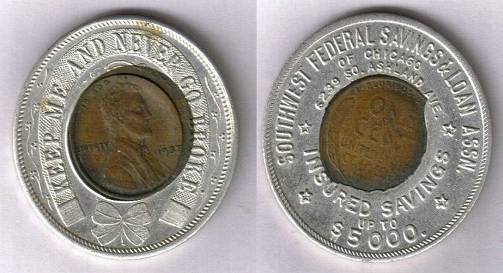

Closing Image (hover for larger image)
For More Information on Encased Refer To
"California Encased Coins And Stickered Coins" By Duane Feisel
PO Box 212, Shingletown, CA 96088-0212
"Catalogs of Michigan, Ohio, and New York Encased" By James M. Lawniczak
Order at; PO Box 14465, Cleveland, Ohio 44114-0465
"Frederick Earl Fankhauser 'the Penny Man' His Life And Work With Encased Coins" - Bryan G. Ryker
I'll also include another author who is active in cataloging encased from Pennsylvania and would appreciate your submissions on the subject.
Victor A. Nolan
PO Box 101850
Pittsburgh, PA 15237
The article above is the sole property of Bob Perdue and may be reprinted only with his permisssion.
If you have an article that you wouild like to share please feel free to contact me! Bruce Perdue Email: Webmaster
Home | Articles | Varieties | Coin Links | About | Terms of Use
Site Copyright 1999-2021 by Bruce Perdue Email: Webmaster All Rights Reserved ©Copyright Bruce Perdue